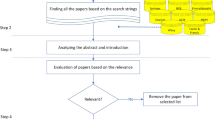Abstract
Recently, social network has been given much attention. This paper addresses the issue of extraction groups from professional social network and enriches the representation of the user profile and its related groups through building a social network warehousing. Several criteria may be applied to detect groups within professional communities, such as the area of expertise, the job openings proposed by the group, the security of the group, and the time of the group creation. In this paper, we aim to find, extract, and fuse the LinkedIn users. Indeed, we deal with the group extraction of LinkedIn users based on their profiles using our innovative semi-supervised clustering method based on quantitative constraints ranking. The encouraging experimental results carried out on our real professional warehouse show the usefulness of our approach.











Similar content being viewed by others
Notes
The data warehouse is built using the available information at http://www.linkedin.com.
References
Bade K, Hermkes M, Nürnberger A (2007) User oriented hierarchical information organization and retrieval. In: Proceedings of the 18th European conference on machine learning. LNCS, pp 518–526
Basu S, Banerjee A, Mooney RJ (2002) Semi-supervised clustering by seeding. In: International conference on machine learning, pp 27–34
Ben Ahmed E, Nabli A, Gargouri F (2012) SHACUN: semi-supervised hierarchical active clustering based on ranking constraints. In: 12th Industrial conference on data mining, Berlin, Germany, pp 194–208
Benitez E, Collet C, Adiba, Entrepôts de données M (2001) caractéristiques et problématique. Revue TSI 20(2)
Bohm C, Plant C (2008) Hissclu: a hierarchical density-based method for semi-supervised clustering. In: Proceedings of the 11th international conference on extending database technology, New York, NY, USA, pp 440–451
Dasgupta S, Ng V (2010) Which clustering do you want? Inducing your ideal clustering with minimal feedback. J Artif Intell Res 39:581–632
Davidson I, Ravi SS (2009) Using instance-level constraints in agglomerative hierarchical clustering: theoretical and empirical results. Data Min Knowl Discov 18(2):257–282
Ghosh Strehl J, Mooney R (2000) Impact of similarity measures on web-page clustering. In: Workshop on artificial intelligence for web search (AAI-2000)
Girvan M, Newman MEJ (2002) Community structure in social and biological networks. Proc Natl Acad Sci USA 99(12):78217826
Gleiser P, Danon L (2003) Community structure in jazz. Adv Complex Syst 6:565
Golfarelli M, Maio D, Rizzi S (1998) Conceptual design of data warehouses from E/R schemes. In: 31st Hawaii international conference on system sciences
Huang R, Lam W (2009) An active learning framework for semi-supervised document clustering with language modeling. Data Knowl Eng 68(1):49–67
Jaccard P (1908) Nouvelles recherches sur la distribution florale. Bulletin de la Société de Vaudoise des Sciences Naturelles, 44:223–270
Jain AK, Dubes RC (1988) Algorithms for clustering data. Prentice-Hall, Upper Saddle River
Kamvar SD, Klein D, Manning CD (2003) Spectral learning. In: International joint conference on artificial intelligence, pp 561–566
Kestler HA, Kraus JM, Palm G, Schwenker F (2006) On the effects of constraints in semi-supervised hierarchical clustering. Artificial Neural Network Pattern Recognition. LNCS, pp 57–66
Kietzmann HJ, Hermkens K (2011) Social media? Get serious! Understanding the functional building blocks of social media. Bus Horiz 54:241251
Klein D, Kamvar SD, Manning CD (2002) From instance-level constraints to space-level constraints: making the most of prior knowledge in data clustering. In: Proceedings of the 19th international conference on machine learning, CA, USA, pp 307–314
MacQueen J (1967) Some methods for classification and analysis of multivariate observations. In: 5th Berkeley symposium on mathematics and statistical probability
Nogueira BM, Jorge AM, Rezende SO (2012) Hierarchical confidence-based active clustering. In: The 27th symposium on applied computing, pp 535–537
Palla G, Barabasi A-L, Vicsek T (2007) Quantifying social group evolution. Nature 446:664–667
Palomares I, Liu J, Xu Y, Martinez L (2012) Modelling experts’ attitudes in group decision making. J Soft Comput 16(10):1755–1766
Quinlan JR (1986) Induction of decision trees. Mach Learn 1(1):81–106
Radicchi F, Castellano C, Cecconi F, Loreto V, Parisi D (2004) Defining and identifying communities in networks. Proc Natl Acad Sci 101(2):2658–2663
Traud AL, Kelsic ED, Mucha PJ, Porter MA Community structure in online collegiate social networks [eprint arXiv:0809.0690]
Tung AKH, Han J, Lakshmanan LVS, Ng RT (2001) Constraint-based clustering in large databases. In: Proceedings of the international conference on database theory (ICDT ’01), London, UK
Wagstaff K, Cardie C, Rogers S, Schroedel S (2001) Constrained K-means clustering with background knowledge. In: International conference on machine learning, pp 577–584
Wasserman S, Faust K (1994) Social network analysis: methods and applications. Cambridge University Press, New York
Xing EP, Andrew YNg, Jordan MI, Russell S (2002) Distance metric learning with application to clustering with side-information. In:Advances in neural information processing system pp 505–512
Author information
Authors and Affiliations
Corresponding author
Rights and permissions
About this article
Cite this article
Ben Ahmed, E., Nabli, A. & Gargouri, F. Group extraction from professional social network using a new semi-supervised hierarchical clustering. Knowl Inf Syst 40, 29–47 (2014). https://doi.org/10.1007/s10115-013-0634-x
Received:
Revised:
Accepted:
Published:
Issue Date:
DOI: https://doi.org/10.1007/s10115-013-0634-x




